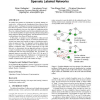101 search results - page 3 / 21 » Why collective inference improves relational classification |
EMNLP
2010
13 years 5 months ago
2010
Several recent discourse parsers have employed fully-supervised machine learning approaches. These methods require human annotators to beforehand create an extensive training corp...
FLAIRS
2010
13 years 9 months ago
2010
When data instances are inter-related, as are nodes in a social network or hyperlink graph, algorithms for collective classification (CC) can significantly improve accuracy. Recen...
CVPR
2006
IEEE
14 years 9 months ago
2006
IEEE
A system that could automatically analyze the facial actions in real time have applications in a number of different fields. However, developing such a system is always a challeng...
KDD
2008
ACM
14 years 7 months ago
2008
ACM
We address the problem of classification in partially labeled networks (a.k.a. within-network classification) where observed class labels are sparse. Techniques for statistical re...
SIGIR
2005
ACM
14 years 17 days ago
2005
ACM
We consider classification of email messages as to whether or not they contain certain “email acts”, such as a request or a commitment. We show that exploiting the sequential ...


